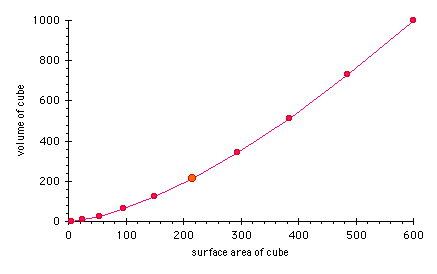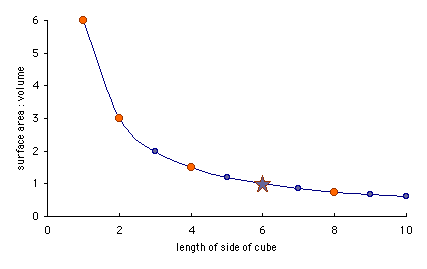![]() and
and ![]()
Introduction: Two- and three-dimensional parameters of organisms (i.e., surface area and volume) do not necessarily increase or decrease proportionally to increases or decreases in one-dimensional, or linear, parameters (i.e., length). For example, the greater the diameter of a single-celled organism, the less surface area it has relative to its volume. The surface area to volume ratio is a way of expressing the relationship between these parameters as an organism's size changes.
Importance: Changes in the surface area to volume ratio have important implications for limits or constraints on organism size, and help explain some of the modifications seen in larger-bodied organisms.
Question: How is the surface area to volume ratio calculated, and how exactly does it change with changing size? What modifications do larger organisms exhibit to get around this problem?
Variables:
| S | surface area (units squared) |
| V | volume (units cubed) |
| l | length (units) |
| r | radius (units) |
Methods: For a single-celled organism (or a cell in a multicellular organism's body, for that matter), the surface is a critical interface between the organism/cell and its environment. Exchange of materials often occurs through the process of diffusion, in which dissolved molecules or other particles move from areas of higher concentration to areas of lower concentration (although some exchange is mediated by cellular mechanisms). This type of exchange is a passive process, and as a result imposes constraints upon the size of a single-celled organism or cell. Materials must be able to reach all parts of a cell quickly, and when volume is too large relative to surface area, diffusion cannot occur at sufficiently high rates to ensure this.
We'll begin with a reminder of some basic geometric formulae. The surface area and volume of a cube can be found with the following equations:
![]() and
and ![]()
where S = surface area (in units squared),
V
= volume (in units cubed), and l = the length of one side of the
cube.

The equations for the surface area and volume of a sphere are:
![]() and
and ![]()
where r is the radius of the sphere.

Interpretation: Each point on the graph below
represents the surface area and volume for cubes that are increasing by
one unit in length, starting with a cube with l = 1. The larger
orange dot is the size of the cube (l = 6) at which surface area
and volume have equal values (although the units are differentó one is
units2 and one is units3). For cubes smaller than
this, surface area is greater relative to volume than it is in larger cubes
(where volume is greater relative to surface area).

Sometimes a graph that shows how the relationship between two variables changes is more instructive. For example, a graph of the ratio of surface area to volume,
![]() ,
,
clearly illustrates that as the size of an object
increases (without changing shape), this ratio decreases. Mathematically,
that tells us that the denominator (volume) increases faster relative to
the numerator (surface area) as object size increases. The star on the
line (at l = 6) represents the same point mentioned above: this
is the size of the cube where S and V have equal values,
and so the surface area to volume ratio is equal to one.

Conclusions: Organisms exhibit a variety of modifications, both physiological and anatomical, to compensate for changes in the surface area to volume ratio associated with size differences. One example of this is the higher metabolic rates found in smaller (homeothermic) animals. Because of their large surface area relative to volume, small animals lose heat at much higher rates than large animals, and therefore must produce more heat to offset the effects of thermal conductance. Another example is the variety of internal transport systems that have developed in plants and animals for actively moving materials throughout the organism, thus enabling them to circumvent the limits imposed by passive diffusion. Many organisms have developed structures that actually increase their surface area: the leaves on trees, the microvilli on the lining of the small intestine, root hairs and capillaries, and the convoluted walls of arteries, to name but a few.
Additional Questions: Calculate and graph the surface area to volume ratio for spheres increasing in one unit increments (beginning with r = 1). Compare the S:V ratio of spheres and cubes of comparable sizes (2r, or diameter, = l).
Extra credit: Graph the surface areas (x axis) and volumes (y axis) of these spheres on a standard plot and a log-log plot. What happens to the line? Why?
Sources: Schmidt-Nielson, K. 1984. Scaling: Why is Animal Size so Important? Cambridge University Press, New York, NY.
Vogel, S. 1988. Life's Devices: The Physical World of Animals and Plants. Princeton University Press, Princeton, NJ.
copyright 2000, M. Beals, L. Gross, S. Harrell